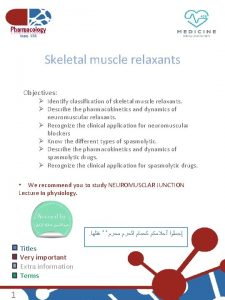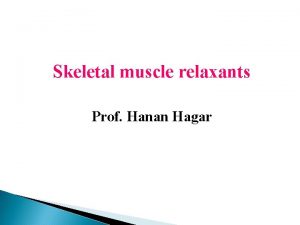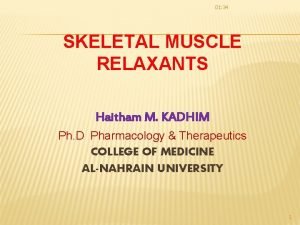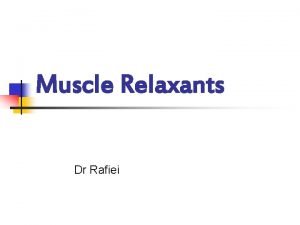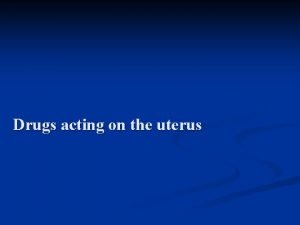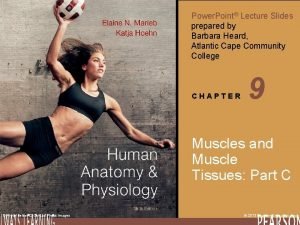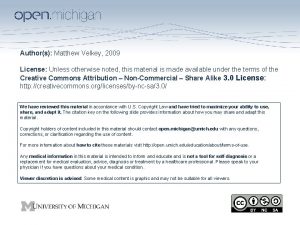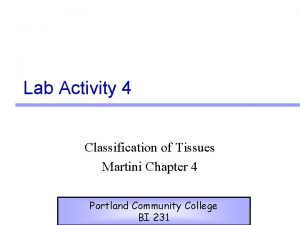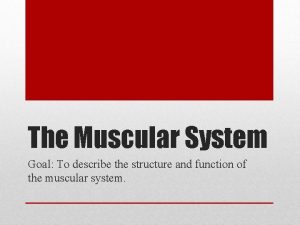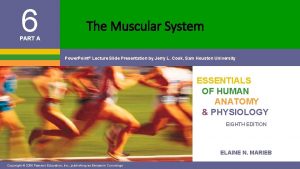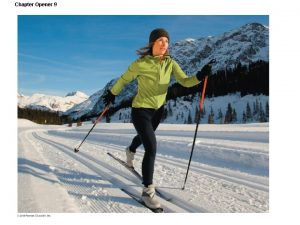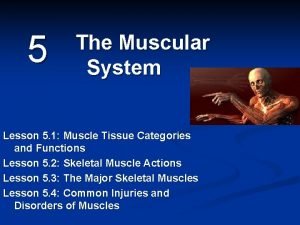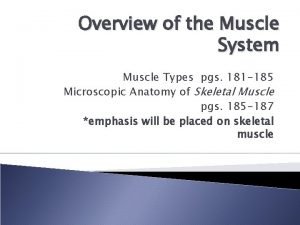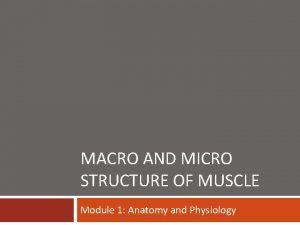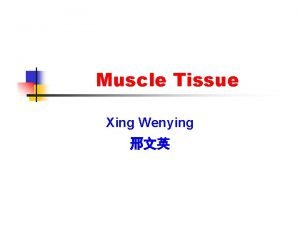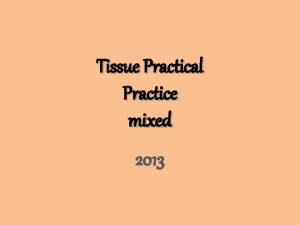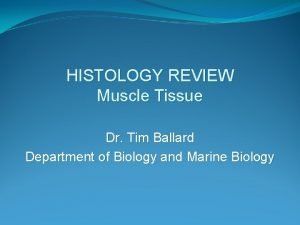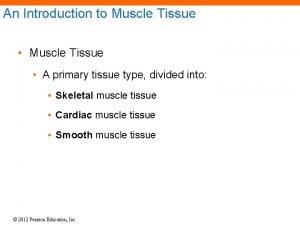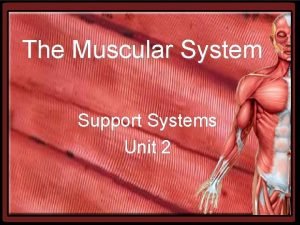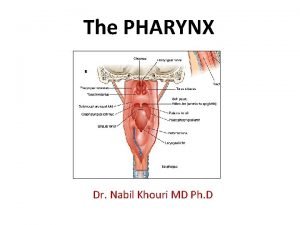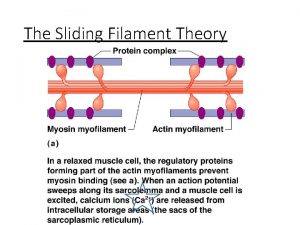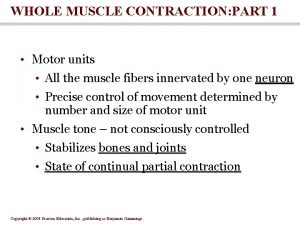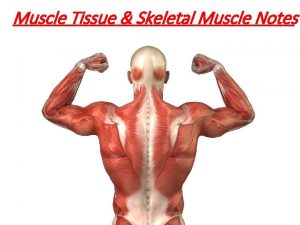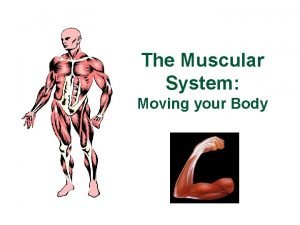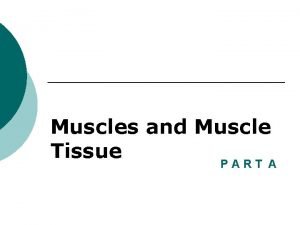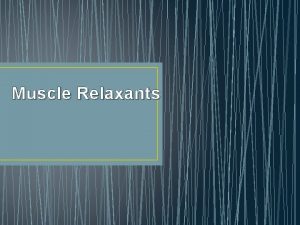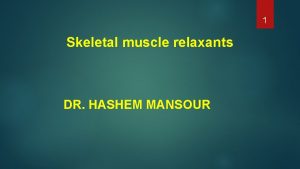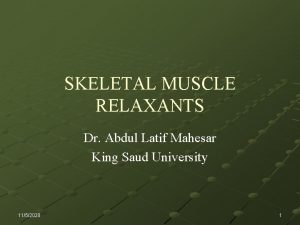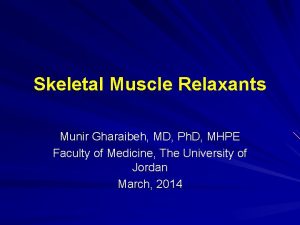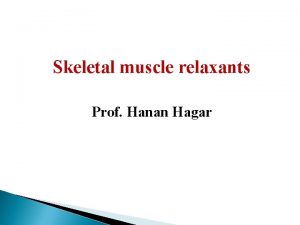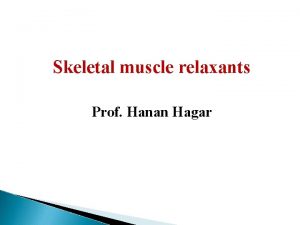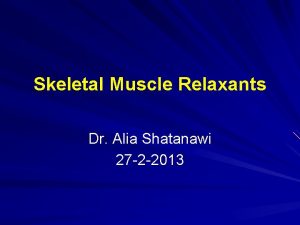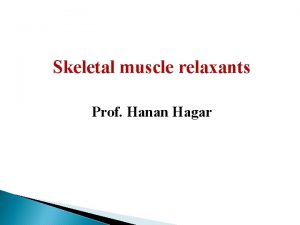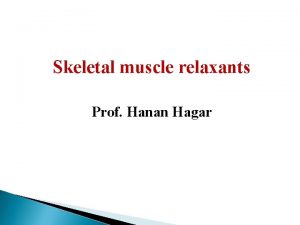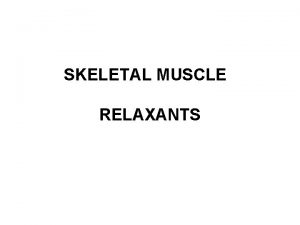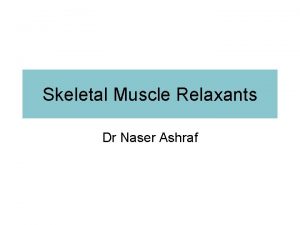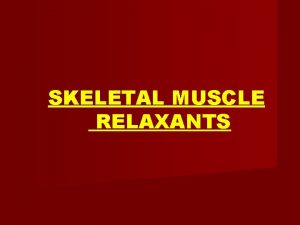SKELETAL MUSCLE RELAXANTS DR D K KATIYAR 1




































- Slides: 36

SKELETAL MUSCLE RELAXANTS DR. D. K. KATIYAR 1

Where to use As adjuvant in surgical anaesthesia to obtained relaxation of skeletal muscle Relaxation of skeletal muscle to make operative manipulations easy. Endotracheal intubation. Counteract laryngospasm during barbiturate anaesthesia. Require lighter level of anaesthesia. Shorten post-anaesthesia recovery period. 2

Cerebral palsy Multiple sclerosis Amyotrophic lateral sclerosis Spinal injuries Trigeminal neuralgia Malignant hyperthermia Muscle spasm of local origin Spondylitis Sprains lumbago 3

10/18/2021 4

Classification on basis of site of action and mechanism of action A) Peripherally Acting Acts at N-M junction fall into two catagories : i- Non depolarizing (Competitive blockers)- prevent access of Ach at Nm rec of motor end plate- prevent depolarization a). Long acting § Pancuronuium, Doxacurium, Pipecuronium b). Intermediate acting § Vecuronium, Atracurium, Rocuronium c). Short acting § Mivacurium, Rapacuronium ii-Depolarizing: Act as agonists at acetylcholine receptors. 5

B) Centrally acting (spasmolytic drugs) Selective action in the cerebrospinal axis. Carisoprodol, Chlorzoxazone, Chlormezanone, Methocarbamol Diazepam, Clonazepam ( act through GABA A receptors) Baclofen (GABA B receptors) Tizanidine (central α 2 agonist) 6

C) Directing acting (spasmolytic drugs) Dantroline ( act directly by interfering release of calcium from sarcoplasmic reticulum) 7

Mechanism of Sk. muscle contraction Initiation of impulse Release of acetylcholine Activation of nicotinic receptor at motor end plate Opening of ion channel, passage of Na+ , depolarization of end plate Muscle contraction. 8

Neuromuscular Junction 1: Cholinergic motor neurone 2: motor end-plate 3: vesicles 4 : N MR

Mechanism of action (non depolarizing agents) a) At low doses: These drugs combine with nicotinic receptors and prevent acetylcholine binding. As they compete with acetylcholine for receptor binding they are called competitive blockers. Thus prevent depolarization at end-plate. Hence inhibit muscle contraction, relaxation of skeletal muscle occurs. 10

Their action can be overcome by increasing conc. of acetylcholine in the synaptic gap (by ihibition of acetyle choline estrase enzyme, e. g. : Neostigmine , physostigmine ) Anaesthetist can apply this strategy to shorten the duration of blockage or overcome the over dosage. 11

At high doses These drugs block ion channels of the end plate. Leads to further weakening of the transmission and reduces the ability of Achesterase inhibitors to reverse the action. 12

ACTIONS All the muscles are not equally sensitive to blockade. Small and rapidly contracting muscles are paralyzed first. Respiratory muscles are last to be affected and first to recover. 13

Pharmacokinetics: Administered intravenously (not absorbed orally as they remain ionized at physiological p. H). Cross blood brain barrier poorly (they are poorly lipid soluble) They have limited volume of distribution as they are highly ionized. 14

Drugs excreted by kidney -Longer duration of action (35 -100 min) Drugs eliminated by liver -Intermediate duration of action (25 -50 min) Drugs inactivated spontaneously in plasma (Hoffmann elimination) -Intermediate duration of action (25 -50 min) Drugs inactivated by plasma cholinesterase -Shorter duration of action (15 -20 min) 15

Atracurium is degraded spontaneously in plasma by ester hydrolysis it releases histamine and can produce a fall in blood pressure , flushing and bronchoconstriction. Its metabolite can provoke seizures. Cisatracurium with similar pharmacokinetics is more safer. 16

Drug interactions Choline esterase inhibitors such as neostigmine, pyridostimine and edrophonium reduces or overcome their activity but with high doses they can cause depolarizing block due to elevated acetylcholine concentration at the end plate. Halothane, aminoglycosides , calcium channel blockers synergize their effect. 17

Unwanted effects Fall in arterial pressure- chiefly a result to ganglion block , may also be due to histamine release. Bronchospasm due to histamine release from mast cells (especially with tubocurarine , mivacurium , and atracurium). Pancuronium block muscarinic receptors also, particularly in heart which may results tachycardia. Hypoxia and respiratory paralysis. 18

DEPOLARIZING AGENTS DRUG- Succinylcholine Mechanism of action: act like acetylcholine but persist at the synapse at high concentration and for longer duration and constantly stimulate the receptor. First, opening of the Na+ channel occurs resulting in depolarization, this leads to transient twitching of the muscle, continued binding of drugs make the receptor incapable to transmit the impulses, paralysis occurs. The continued depolarization makes the receptor incapable of transmitting further impulses. 19

Therapeutic uses: When rapid endotracheal intubations is required. Bronchoscopy laryngoscopy Electroconvulsive shock therapy. Pharmacokinetics: Administered intravenously. Due to rapid inactivation by plasma cholinestrase, given by continued infusion. 20

Succinylcholine (cont) • It causes paralysis of skeletal muscle. Sequence of paralysis may be different from that of non depolarizing drugs but respiratory muscles are paralyzed last. Produces a transient twitching of skeletal muscle before causing block. It causes maintained depolarization at the end plate, which leads to a loss of electrical excitability. It has shorter duration of action (5 -10 min). 21

It stimulate ganglion (sympathetic and para sympathetic both). In low dose it produces negative ionotropic and chronotropic effect In high dose it produces positive ionotropic and chronotropic effect. 22

It act like acetylcholine but diffuse slowly to the end plate and remain there for long enough that the depolarization causes loss of electrical excitability If cholinestrase is inhibited , it is possible for circulating acetylcholine to reach a level sufficient to cause depolarization block. 23

Unwanted effects: Bradycardia (preventable by atropine). Hyperkalemia in patients with trauma or burns. this may cause arrhythmia or even cardiac arrest. Increase intraocular pressure due to contracture of extra ocular muscles. increase intragastric pressure which may lead to emesis and aspiration of gastric content. 24

Malignant hyperthermia: rare inherited condition probably caused by a mutation of Ca++ release channel of sarcoplasmic reticulum, which results muscle spasm and dramatic rise in body temperature. (This is treated by cooling the body and administration of Dantrolene) Prolonged paralysis: due to factors which reduce the activity of plasma cholinesterase genetic variants as abnormal cholinesterase, its severe deficiency. anti -cholinesterase drugs neonates liver disease 25

Characteristics of neuromuscular-blocking drugs 10/18/2021 26

Some properties of neuromuscular blockers Drug Elimination Approximate potency relative to Tubocurarine Atracurium spontaneous 1. 5 Doxacurium kidney 6 Mivacurium Plasma cholinesterase 4 Metocurine Kidney 40% 4 Tubocurarine Kidney 40% 1 Panacurium Kidney 80% 6 Rocuronium Liver 70 -80%, kidney 0. 8 vecuronium Liver 75 -90%, kidney 6 pipecuronium Kidney , liver 6 Rapacuronium liver 0. 4 27

10/18/2021 28

Centrally acting muscle relaxants (Spasmolytic Drugs) Mephenesin group. Carisoprodol, Chlorzoxazone, Chlormezanone, Methocarbamol Diazepam, Clonazepam ( act through GABA A receptors) Baclofen (GABA B receptors) Tizanidine (central α 2 agonist) 29

Mechanisms underlying spasticity involve - stretch reflex arc itself -also higher centers in the CNS (ie, upper motor neuron lesion), with damage to descending pathways in the spinal cord resulting in hyperexcitability of the alpha motoneurons in the cord. 30

Pharmacologic therapy - ameliorate some of the symptoms of spasticity by modifying the stretch reflex arc -or by interfering directly with skeletal muscle (ie, excitation-contraction coupling). 31

Baclofen It acts through GABA- B receptors It causes hyper polarization by increased K+ conductance, reducing calcium influx and reduces excitatory transmitter in brain as well as spinal cord It also reduces pain by inhibitory substance P. in spinal cord It is less sedative It is rapidly and completely absorbed orally It has a half life of 3 - 4 hours It may increases seizures in epileptics It is also useful to prevent migraine. 32

Tizanidine has significant (α 2), adrenoceptor agonist effects tizanidine reinforces both presynaptic and postsynaptic inhibition in the cord. It also inhibits nociceptive transmission in the spinal dorsal horn. 33

Dantrolene It acts directly It reduces skeletal muscle strength by interfering with excitation-contraction coupling into the muscle fiber, by inhibiting the release of activator calcium from the sarcoplasmic stores. It is very useful in the treatment of malignant hyperthermia caused by depolarizing relaxants. This drug can be administered orally as well as intravenously. Oral absorption is only one third. Half life of the drug is 8 -9 hours. 34

Sites of spasmolytic action of tizanidine (α 2), benzodiazepines (GABAA), and baclofen (GABAB) in the spinal cord. Tizanidine may also have a postsynaptic inhibitory effect. Dantrolene acts on the sarcoplasmic reticulum in skeletal muscle. Glu, glutamatergic neuron.

Thank you 36
 Skeletal muscle relaxants classification
Skeletal muscle relaxants classification Classification of skeletal muscle relaxant
Classification of skeletal muscle relaxant Muscle relaxants classification
Muscle relaxants classification Skeletal muscle relaxants classification
Skeletal muscle relaxants classification Centrally acting skeletal muscle relaxants
Centrally acting skeletal muscle relaxants Skeletal muscle relaxants classification
Skeletal muscle relaxants classification Dr rafiei
Dr rafiei Muscle refractory period
Muscle refractory period Uterus stimulant drugs
Uterus stimulant drugs Comparison of skeletal cardiac and smooth muscle
Comparison of skeletal cardiac and smooth muscle Skeletal muscle longitudinal section labeled
Skeletal muscle longitudinal section labeled Pseudostratified vs simple columnar
Pseudostratified vs simple columnar 5 function of muscular system
5 function of muscular system Microscopic anatomy of skeletal muscle figure 6-2
Microscopic anatomy of skeletal muscle figure 6-2 Comparison of skeletal cardiac and smooth muscle
Comparison of skeletal cardiac and smooth muscle Lesson 5.1 the organization of a skeletal muscle
Lesson 5.1 the organization of a skeletal muscle Dorsifelxion
Dorsifelxion Sarcoplasmic
Sarcoplasmic Muscle cell structure
Muscle cell structure Cardiac muscle
Cardiac muscle Somatic vs autonomic nervous system
Somatic vs autonomic nervous system What tissue is this
What tissue is this Skeletal muscle tissue
Skeletal muscle tissue Trunk muscles
Trunk muscles Skeletal muscle contraction steps
Skeletal muscle contraction steps Muscles of the forearm
Muscles of the forearm Skeletal muscle origin
Skeletal muscle origin Thigh cross section
Thigh cross section Pharynx anatomy
Pharynx anatomy 5 golden rules of skeletal muscle activity
5 golden rules of skeletal muscle activity Physiology of muscle contraction
Physiology of muscle contraction Nerve supply to muscles
Nerve supply to muscles Anatomy of skeletal muscle
Anatomy of skeletal muscle Cardiac skeletal and smooth muscle comparison
Cardiac skeletal and smooth muscle comparison Organization of muscle fibers
Organization of muscle fibers Types of muscle tissue
Types of muscle tissue Skeletal muscle tone
Skeletal muscle tone
